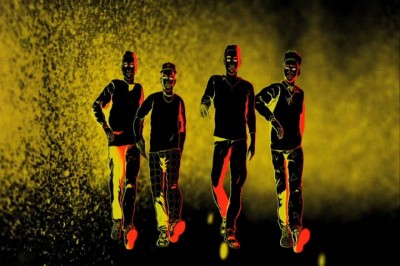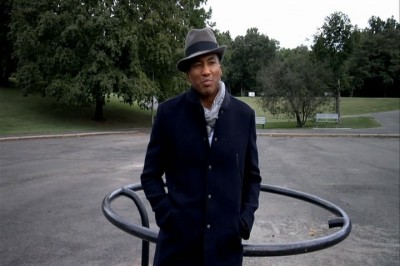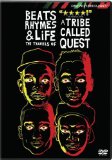| Reviews & Columns |
|
Reviews DVD TV on DVD Blu-ray 4K UHD International DVDs In Theaters Reviews by Studio Video Games Features Collector Series DVDs Easter Egg Database Interviews DVD Talk Radio Feature Articles Columns Anime Talk DVD Savant Horror DVDs The M.O.D. Squad Art House HD Talk Silent DVD
|
DVD Talk Forum |
|
|
| Resources |
|
DVD Price Search Customer Service #'s RCE Info Links |
|
Columns
|
|
|
Beats, Rhymes & Life: The Travels of a Tribe Called Quest
I tend to be a grouchy old man when it comes to discussing music, in part because I think today's tunes tend to lack any real coherence. However, it is encouraging to see artists such as Pharrell and Kanye West acknowledge or (in some cases) reference A Tribe Called Quest in their music. I remember listening to some songs from the hip hope group growing up and enjoyed them immensely. They released six albums before disbanding in 1998 and this documentary film, titled Beats, Rhymes & Life looks into the origins of the musicians and the influence they had within the hip hop genre.
The group (comprised of Jarobi White, Ali Shaheed Muhammad, Phife Dawg and Q-Tip) got together in high school in the late 1980s, with Phife and Tip being friends since childhood. In the group's debut album "People's Instinctive Travels and the Paths of Rhythm," fans were introduced to rhymes that were almost stream of consciousness in their style, but set to creative drum loops and bass lines that made you nod your head to the time almost instantly. Their second album "Low End Theory" was a breakout success across races, and songs like "Check The Rhime" were among the popular tracks on an album where hip-hop and jazz flowed seamlessly, a testament to the group's influences. Their popularity was rising, to the point where they would appear in some alternative music festivals in the early 1990s. The film includes interviews with peers of the era and modern day musicians as they talk about Tribe's brilliance and the reasons why they were so influential.

With the band's rising popularity begot internal strife. White left the band before "Low End Theory" to become a chef, even going to culinary school. The childhood friends Phife and Tip became acrimonious through the years. Tip's reputation as a perfection is discussed in the piece (to the point where he's equated to Axl Rose), and the two eventually devolve into a fight shortly before going on stage at a concert for the Rock the Bells 2008 series, a tour of hip-hop friends and musicians. There is talk that when you're friends with someone for awhile, something that would be a minor slight to some could be blown up, and a seemingly innocuous challenge to Phife to get his stage game up (while Phife was touring and dealing with kidney dialysis) was treated as an insult. As Jamie Rich mentioned in his review, it's truly a Let It Be moment of its own. The film has an unexpected and poignant turn with Phife's health issues, leading to a storybook-like reconciliation of sorts for the group. Whether they will make another record or not remains to be seen (and is largely doubtful), but the future relationships each member has with one another appear to be solid.
The first thing that surprised me about this documentary was that it was directed by Michael Rapaport, a veteran actor who many will recognize from his role as Dick Ritchie in True Romance. More important to this film though, Rapaport grew up in New York and was a fan of A Tribe Called Quest, De La Soul, and the many other hip-hop artists that came out of New York to later find success in music. He listened to the same radio shows as they did, recording many of the same songs off the radio (to cassette tape), and later pored over the new albums of his favorite bands when they came out. I think there are some deficiencies in Rapaport's film (mainly showing us that the music was great without telling you much in why it was), but his passion for the material comes through and forgives most of the flaws.

Moreover, his passion for the group, combined with some incredibly lucky timing in capturing the 2008 dust-up on camera, helps make Beats, Rhymes & Life a better than expected film. Even if you are oblivious to the hip-hop genre, Rapaport helps illustrate why A Tribe Called Quest's music remains so important and significant, and shows us that band member relationships are tenuous at times, regardless of genre. Speaking as one who wakes up to "Can I Kick It?" as the song on his alarm clock most days, I can say without equivocation that I not only learned more about the group than I knew, but have a newfound appreciation and respect for what they did as artists.
The Discs:Video:
Beats, Rhymes & Life is presented in 1.78:1 anamorphic widescreen, and the results are good. With a mix of handheld video camera shots and actual (8mm and 16mm) film capturing the performances, to say nothing of the old videos from back in the day, the disc juggles them all adequately. There is a bit of image noise during the concert stuff, but that was to be expected a bit. Otherwise, the film is generally low fidelity in visuals, and this isn't any clearer than during the pre-concert fight between Q-Tip and Phife. However, it remains a solid video presentation from Sony.
Audio:Dolby Digital 5.1 surround for the feature, and frankly, I wouldn't have expected anything else. From the opening bass line of "Can I Kick It?" (which many will remember as Lou Reed's "Walk on the Wild Side") in the credits to the videos and concert performances, the songs sound clean and the soundstage is broad, with ample immersion from the rear channels and activity from the subwoofer. Dialogue is consistent and strong through much of the film and requires little in the way of adjustment. Overall, the music is the star of the film and gets its justice with the soundtrack.
Extras:Rapaport does a commentary for the film that isn't shabby. He covers the inspiration for the film along with some shot recollections and style choices he made, and spots some trivia about the group along the way. He fills in some historical gaps as well and talks about the personal impact of the music for him. It's an active track and much different than you're going to listen to, but there's an incomplete nature to it which I can't put my finger on. Next is "Bringing Beats To Life" (10:20), in which the process of making the low-fidelity (but really cool) opening credit sequence is show. There are interviews with Rapaport and the musicians at the film's premiere at the Los Angeles Film Festival (5:12), but those are fairly superficial. Less so are the deleted scenes (6, 25:04), where the band discusses the possibility of a new album and musicians reflect further on the band's influence. I'm glossing over this a bit but there is some excellent footage here. The film's trailer (2:23) rounds the disc out. As a postscript, there are a bounty of additional extras on the Blu-ray disc, as Rich and Jason Bailey mention in their reviews.

Beats, Rhymes & Life is not just a documentary about a hip-hop group but a quality contribution into the musical documentary genre. The fact that A Tribe Called Quest is at the center of it is just gravy on the biscuit. Technically, it's a decent disc but if you have a Blu-ray player, you'll likely want to take advantage of the improved audio and additional extras. If you don't, this standard definition disc is solid regardless.
|
| Popular Reviews |
| Sponsored Links |
|
|
| Sponsored Links |
|
|
| Release List | Reviews | Shop | Newsletter | Forum | DVD Giveaways | Blu-Ray | Advertise |
|
Copyright 2024 DVDTalk.com All Rights Reserved. Legal Info, Privacy Policy, Terms of Use,
Manage Preferences,
Your Privacy Choices | |||||||













